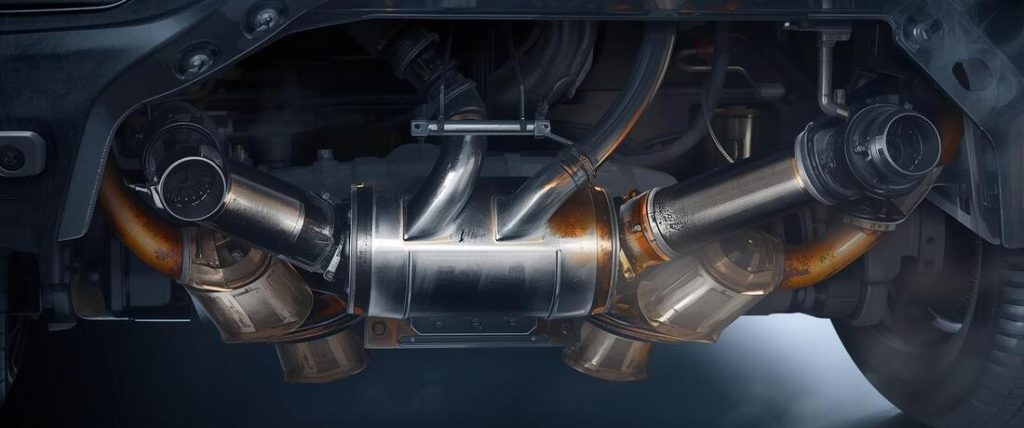This article was updated in November 21, 2025 with new products and information by Mark S. Taylor
If your car is making strange noises, smells like rotten eggs, or isn’t running as smoothly, you might have a bad catalytic converter. This part of your car helps control emissions and keeps the engine running clean. But when it fails, your car’s performance drops, and it can cost you big in repairs. Don’t panic, though! Spotting the signs early can save you money and keep your car on the road longer. In this guide, I’ll walk you through the common symptoms of a bad catalytic converter, how to diagnose it, and what to do next.

Contents
What Is a Catalytic Converter and Why It Fails
A catalytic converter is a key part of your car’s exhaust. It cleans bad gases before they leave your car. This helps keep our air clean. When it fails, your car runs poorly. It also harms the air we breathe.
How Catalytic Converters Work
The converter has special metals inside. These metals change bad gases into good ones. Think of it as a filter for your car’s exhaust. It works best when hot. That’s why your car needs to warm up first.
Common Reasons for Failure
Converters fail for three main reasons. First, bad engine problems can harm it. Second, it can get too hot. Third, it can get hit and break. Most last 10-15 years if you care for your car.

Top 8 Symptoms of a Bad Catalytic Converter
Spotting bad converter signs early saves you money. These signs range from easy to see to hard to notice. Here are the 8 key signs that tell you your converter might be bad:
1. Check Engine Light (P0420/P0430 Codes)
The check engine light is often the first sign. When the converter works poorly, your car’s computer shows a code. These codes are P0420 or P0430. They mean your converter isn’t cleaning the exhaust well. If you see these codes, test your converter soon.
2. Rotten Egg or Sulfur Smell
A bad converter often makes a bad smell. It smells like rotten eggs. This comes from sulfur in your fuel. The converter should turn this into clean air. When it can’t, you smell the bad egg smell. It gets worse as the converter gets worse.
3. Sudden Loss of Power & Sluggish Acceleration
A clogged converter blocks air flow. This makes your car feel weak. It struggles to speed up. You might press the gas more to get the same power. This gets worse over time as the converter gets more clogged.
4. Poor Fuel Economy
A bad converter makes your car use more gas. Your engine works harder to push air through. This burns more fuel. You might need to fill up more often. This sign starts small but gets bigger as the problem grows.
5. Rattling Noise Under the Car
A rattle under your car means the converter is broken inside. The honeycomb part can break apart. These pieces shake and make noise. You hear it most when the car is cold. If you hear this sound, your converter needs help soon.
6. Dark Exhaust Smoke
Some smoke is normal. But very dark smoke is a bad sign. A bad converter can’t clean the exhaust well. This makes the smoke look dark. Often, other engine problems cause this too. If you see dark smoke, check the converter and engine.
7. Engine Overheating or Misfiring
A very clogged converter can make your engine too hot. It blocks the hot air from leaving. This makes your engine run hot. Sometimes it makes your engine miss or run rough. These are serious signs. You need to fix them fast.
8. Failed Emissions Test
Many places test your car’s emissions each year. A bad converter will make you fail this test. The converter’s job is to clean the exhaust. When it fails, your car makes too much bad air. If you fail a test, the converter is often why.
| Symptom | How Bad (1–10) | Easy Fix? |
|---|---|---|
| Check Engine Light | 6 | Scan first |
| Rotten Egg Smell | 7 | Usually replace |
| Loss of Power | 9 | Urgent |
| Poor MPG | 5 | Monitor |
| Rattling | 10 | Replace ASAP |
| Dark Smoke | 8 | Check fuel too |
| Overheating/Misfire | 10 | Stop driving |
| Failed Emissions | 7 | Legal issue |
How to Test Your Catalytic Converter at Home (3 Simple Ways)
You can check your converter at home with simple tools. These tests help you know if your converter is bad. Let’s look at three easy ways to test it:
Visual Inspection
First, look at your converter. Check for dents or rust. Look for color changes. These might show damage or heat issues. Use a light to see inside if you can. Look for broken parts or clogs. This simple check can show big problems.
Using an OBD-II Scanner
An OBD-II scanner helps you read your car’s codes. Plug it in under your dash. Look for codes P0420 or P0430. These codes mean your converter is bad. Many scanners also show sensor data. This helps you know if the converter works right.
Temperature & Back-Pressure Test
The temperature test checks heat at both ends of the converter. Use a heat gun to measure. The exit should be hotter than the entry. This shows the converter is working. The pressure test checks how much air gets stuck. Too much pressure means the converter is clogged. These tests need tools but give good answers.
Can You Drive with a Bad Cat? (Risks Explained)
Driving with a bad converter has risks. It can harm your car and our air. You might drive a short way with a small problem. But big problems need fast help. Knowing these risks helps you decide what to do.
Short-term vs. Long-term Risks
At first, a bad converter might just hurt your gas use. But driving with a very bad converter can cause big harm. It can make your engine too hot. It can break other parts. It might even stop your car completely. The long-term risk is more cost and more damage.
Legal and Environmental Concerns
Most places have laws about bad converters. You might not pass your emissions test. This can stop you from registering your car. A bad converter also makes our air dirty. It puts bad gases into the air we breathe. These gases can harm people and our world.
Average Replacement Cost in 2026
Converter costs vary a lot. It depends on your car and the part you choose. In 2026, you might pay $200 to $2,500. Knowing your options helps you plan and save money.
Parts vs. Labor Costs
The converter part costs $100 to $2,000. The price changes with your car type. Common cars cost less. Special cars cost more. Work costs $100 to $500. Some converters are easy to change. Others take more time and work.
OEM vs. Aftermarket Options
OEM parts come from your car’s maker. They cost more but fit just right. Aftermarket parts come from other companies. They cost less but work well too. In 2025, aftermarket parts are very good. They work for most cars and save money.
DIY vs. Professional Installation
You might change the converter yourself. This saves money on work. But the job can be hard. Rusty bolts make it tough. Some cars need special tools. A pro does it right and fast. They also give a warranty on their work. If you try DIY, be ready for hard parts.
Factors That Affect Total Cost
- Make/model (Prius or truck = expensive)
- Location (California CARB cats cost more)
- Number of cats (some cars have 3–4)
| Vehicle Example | Average Total Cost (2026) |
|---|---|
| Honda Civic | $1,200–$2,800 |
| Ford F-150 | $1,500–$3,500 |
| Toyota Prius | $2,500–$4,500 |
| Chevy Silverado | $1,000–$2,500 |
Preventing Future Catalytic Converter Problems
Preventing converter problems saves money. With good care, your converter can last a long time. These tips help you avoid the cost of a new converter.
Regular Maintenance Tips
Good engine care protects your converter. Keep your engine tuned well. This stops misfires that harm the converter. Change spark plugs and wires on time. Fix oil or coolant leaks fast. These fluids can damage the converter. Use the right fuel for your car.
Warning Signs to Watch For
Watch for early signs of engine problems. These can harm your converter later. Look for check engine lights. Notice bad smells or less power. These signs mean something is wrong. Fix them fast to protect your converter. Listen for odd sounds from your exhaust too.
FAQ About Symptoms of a Bad Catalytic Converter
Q: What can be mistaken for a bad catalytic converter?
A: Bad sensors, exhaust leaks, and engine misfires can seem like a bad converter. These problems can show the same warning lights. So check all parts before you change the converter.
Q: How to unclog a catalytic converter?
A: Some cleaners say they can unclog converters. But bad clogs need a new part. Small issues might get better with fuel additives. But these don’t work well for big problems.
Q: What will happen if I drive with a bad catalytic converter?
A: Driving with a bad converter can use more gas. It can harm your engine from back pressure. You might fail emissions tests. In bad cases, a clogged converter can make your engine too hot or stop it.
Q: How do I know if I have a bad O2 sensor or catalytic converter?
A: Codes can tell you the difference. O2 sensor codes show sensor problems (P0130-P0167). Converter codes (P0420, P0430) show converter issues.
Q: What causes a catalytic converter to fail suddenly?
A: Sudden failure often comes from engine problems. Bad misfires put too much fuel in the exhaust. This makes the converter too hot. Hitting the converter can also break it fast.
Bottom Line – Quick Verdict
If you see 2 or more signs, check your codes today. Most bad converters come from engine problems you ignore. Fix those first to save money. A converter is a big part of your car. Fix problems early to avoid big costs later. With good care, your converter can last as long as your car.
Quick Summary
- A converter turns bad gases into good ones.
- Signs of a bad converter include warning lights, bad smells, and less power.
- You can test a converter with a visual check, code reader, or heat test.
- Driving with a bad converter can harm your engine and our air.
- New converters cost $200 to $2,500 based on your car and part choice.
- Good engine care helps your converter last longer.
- If you see many signs, get help fast to avoid big repair bills.
